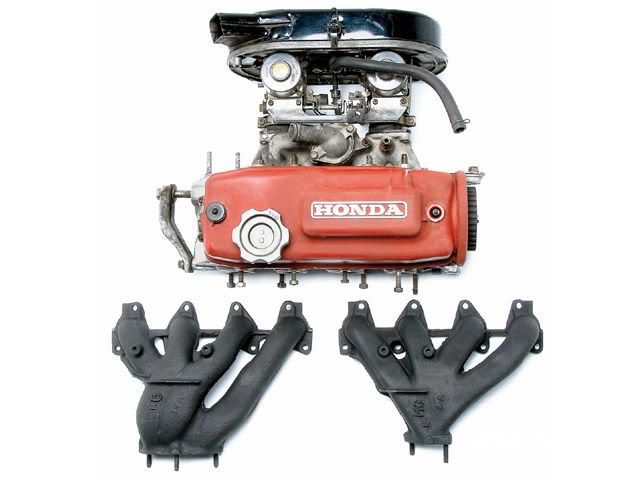Jay417
Beast From The East
Found this on Hondatuning and...well read on.
Original Type R

If there's one person who knows a thing or two about old-school Honda paraphernalia, it's Oscar Jackson. Often credited as a pioneer of modern-day Honda performance, Jackson has collected just as many ground-breaking parts as he's created. Among the many artifacts in his collection is his Civic "R Type" engine, a Japanese version of the '73-'79 Civic 1200 that was sold in the U.S. Though it wasn't known as a performance car by any means, its Japanese brethren proved to be ahead of its time. Noteworthy differences include the engine's intake and exhaust. Instead of the U.S. model's two-barrel downdraft carburetor, the R Type features dual side draft carburetors for better airflow. And the Japanese version features a true Tri-Y exhaust manifold (pictured on left) in contrast to the U.S. engine's restrictive short-runner design. The Tri-Y design was so innovative that it continues to influence exhaust manifolds to this day-both aftermarket and OEM-like with the Integra Type R's B18C manifold, for example. It's hard to believe, but Honda's engineers developed this design almost 40 years ago, yet it remains relevant, even by today's standards.
Of course, guys like Oscar Jackson aren't ones to leave engines like the Civic's R Type alone. He took his time with it, carefully opened it up, and found out what exactly made it tick. Upon closer inspection of the cylinder head he found several differences between the two engines. "The magic in these engines, as is standard procedure with Honda and its Type R engines, is the cylinder head. Although externally the JDM Type R heads look exactly the same as the USDM heads, they were light-years better. The R heads had 3mm larger valves and the actual angle of the valve was modified so that the valve spring base casting did not protrude into the intake port," Jackson says. In simple terms, this meant that a higher rate of airflow combined with a better valve angle resulted in better performance.
Honda introduced the '73 Civic 1169cc EB1 engine to the U.S. first, followed by the slightly larger 1234cc EB2 engine in 1974, and the similarly displaced EB3 engine in 1978, which shares the same cylinder head as the R Type engine. But the top ends weren't identical; U.S. models lacked the dual carburetors and the trick Tri-Y manifold. Some things never change. The R Type's story further demonstrates the fact that old-school technology will always have a place in the modern-day performance arena. Never, ever forget your roots.
HondaTuning Article.

Honda KING OF N/A ENGINES since the begining. k:
k:
Original Type R

If there's one person who knows a thing or two about old-school Honda paraphernalia, it's Oscar Jackson. Often credited as a pioneer of modern-day Honda performance, Jackson has collected just as many ground-breaking parts as he's created. Among the many artifacts in his collection is his Civic "R Type" engine, a Japanese version of the '73-'79 Civic 1200 that was sold in the U.S. Though it wasn't known as a performance car by any means, its Japanese brethren proved to be ahead of its time. Noteworthy differences include the engine's intake and exhaust. Instead of the U.S. model's two-barrel downdraft carburetor, the R Type features dual side draft carburetors for better airflow. And the Japanese version features a true Tri-Y exhaust manifold (pictured on left) in contrast to the U.S. engine's restrictive short-runner design. The Tri-Y design was so innovative that it continues to influence exhaust manifolds to this day-both aftermarket and OEM-like with the Integra Type R's B18C manifold, for example. It's hard to believe, but Honda's engineers developed this design almost 40 years ago, yet it remains relevant, even by today's standards.
Of course, guys like Oscar Jackson aren't ones to leave engines like the Civic's R Type alone. He took his time with it, carefully opened it up, and found out what exactly made it tick. Upon closer inspection of the cylinder head he found several differences between the two engines. "The magic in these engines, as is standard procedure with Honda and its Type R engines, is the cylinder head. Although externally the JDM Type R heads look exactly the same as the USDM heads, they were light-years better. The R heads had 3mm larger valves and the actual angle of the valve was modified so that the valve spring base casting did not protrude into the intake port," Jackson says. In simple terms, this meant that a higher rate of airflow combined with a better valve angle resulted in better performance.
Honda introduced the '73 Civic 1169cc EB1 engine to the U.S. first, followed by the slightly larger 1234cc EB2 engine in 1974, and the similarly displaced EB3 engine in 1978, which shares the same cylinder head as the R Type engine. But the top ends weren't identical; U.S. models lacked the dual carburetors and the trick Tri-Y manifold. Some things never change. The R Type's story further demonstrates the fact that old-school technology will always have a place in the modern-day performance arena. Never, ever forget your roots.
HondaTuning Article.

Honda KING OF N/A ENGINES since the begining.

